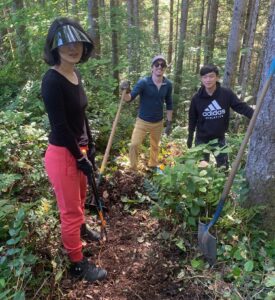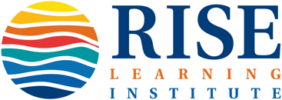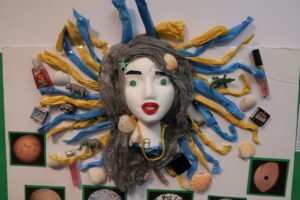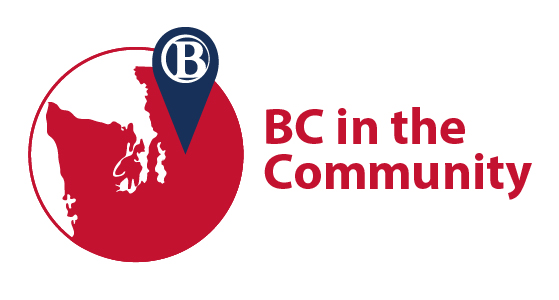What is Service-Learning?
Community-Engaged & Civic Education helps students meet their course learning outcomes, build lifelong skills, and develop a greater sense of civic responsibility. The most well-known type of community-engaged learning is Academic Service-Learning, which provides opportunities for students to contribute to community-based organizations (e.g. nonprofits and government) to meet course outcomes. This helps students make real what they’re learning in their class, and critical reflection activities or assignments facilitate the extraction of learning that goes beyond the course content.

RISE’s CECE program defines Service-Learning simply as:
- Curriculum integration to meet course outcomes, AND
- Contribution towards community-identified needs, AND
- Critical reflection to promote deep learning
With this definition, any course in which students contribute to the community as a part of the course can count as service-learning. For example, students can:
- Volunteer off- or on-campus with community-based organizations (CBOs) consisting of nonprofit, government, or BC agencies
- Develop tools, resources, or media for them as a project
- Conduct research that benefit these agencies
- Support community outreach or education
Civic actions, such as activism and government engagement, are not traditionally considered a part of service-learning, as they do necessarily involve community partners. Nevertheless, civic engagement can still meet RISE’s definition of Service-Learning if it helps students contribute to the community as an integrated part of a class.
Service-learning is intentionally built into the class, either as a single assignment or throughout the quarter. Orientations and syllabus content help prepare students for their experiences, while critical reflections and other assignments help them process throughout and after the experiences.
Some examples of service-learning at Bellevue College, as per the definition above:
- Nutrition – Students take shifts with local food banks to see the fight against food insecurity and malnutrition in their communities
- Sociology – Students volunteer for 16 hours with local CBOs and apply sociological principles to the experience
- Food Chemistry – Online students engage with meal sharing (e.g. soup kitchens) as a way to apply content knowledge in community settings
- English as a Second Language – Students volunteer to practice English in context while learning about the community in which they live
- Health & Wellness – Aspiring professionals volunteer for 30+ hours with wellness organizations to understand volunteer management
- Business Intelligence Capstone – Teams of students spend two quarters developing data warehousing systems for nonprofits
- Documentary Filmmaking – Student production teams create mini-documentary films for local nonprofits that can be used for education and/or promotional purposes
- Technical Writing – Students create brochures, training manuals, grant proposals, etc. for CBOs
- 2D Design (Digital Media Arts) – Students create infographics for local nonprofits that capture data and information in an easily understandable and creative format
- Environmental Ethics – Students analyze environmental policies of local organizations from the perspectives of ethics
- Criminal Justice – Students research juvenile detention rates, types of interventions, and more, across Washington State counties to help a nonprofit guide county governmental agencies on their policies
- Environmental Science – Students conduct localized plant analyses to provide data to an ongoing research program through a local Tribe
- Political Science – Local nonprofits pose questions that frame and give authenticity to research projects that examine issues through political contexts
- Macroeconomics – Students write open letters to companies calling out inhumane or unsustainable business practices, and convince others to sign on to the letters
- Nursing – Pediatric nursing students create public service announcements about important issues they then share with local nonprofits and community organizations
- Technical Writing – Student teams create proposals to convince companies and other organizations to institute more sustainable practices
- Marine Biology – Students formulate community education campaigns around plastic waste
How Do I Develop a Service-Learning Course?
A successful service-learning course brings together the 3 C’s: Course Outcomes, Community-Identified Needs, and Critical Reflections. It can take effort to create a well-integrated, asset-based, critically reflective service-learning class. We recommend that you take advantage of the resources RISE has to offer through the RISE website and the Service-Learning SharePoint, or set up a meeting to talk through your ideas and seek support to lessen the work.
Course Outcomes
The first rule of curricular, or academic, service-learning is that it must be connected to course outcomes. The community or civic engagement becomes another text, something that conveys information that is then linked to course outcomes via assignments and assessments. There is no need to seek approval for new outcomes; just as different instructors use different methods to help students meet the same learning outcomes, service-learning is one method in that toolkit.
Best Practices
- At least one approved learning outcome must be assessed using service-learning or community engagement as a source of content.
- Some concepts or skills can be enhanced through real-world applications or civic experience; focusing on these helps with the process of integrating service-learning into the class.
- Instructors should be intentional about what non-academic outcomes students should meet; for example, because teamwork or social awareness might be important transferable skills or civic engagement outcomes for the class, and can be connected to the service-learning experience, they should be purposefully integrated into lessons or assignments.
Community-Identified Needs
Put simply, this is the partnership component of service-learning. Most instructors will provide opportunities for students to work with community-based organizations that understand how the students can best support them. Serving at partners agencies allows the instructor to rely on experts in the field, thus easing their amount of work while providing students with meaningful civic experiences. Sometimes these engagement opportunities are coordinated with the community partners before the class ever starts, and sometimes students work to build the relationships themselves.
Best Practices
- The needs of the community must be identified by the community. This may not always lead to the most exciting opportunities for students, but an agency that feels heard and appreciated will work harder to provide a meaningful experience for students.
- RISE lessens the pressure to find partners and opportunities by doing much of this work in advance. The BC in the Community portal has over 150 local nonprofits, government agencies, and BC offices that have agreed to collaborate with students. RISE can also help faculty find community-identified projects and research opportunities that meet the needs of classes; faculty should approach RISE at least 2 months prior to the teaching quarter for support.
- No matter the format of service-learning, students should be encouraged to approach the experience with an asset-based, rather than deficit-based, mindset. Communities have a lot to offer and teach us; “service” goes both ways. Faculty can talk with RISE about how best to convey this difference to students.
- Even if an agency is too busy to have anything more than a transactional relationship with faculty, most still appreciate communication throughout the quarter.
Critical Reflection
This tool draws the learning from the experience and applies it to the course outcomes. This also helps students develop lifelong skills and build their civic engagement, both of which are important effects of community-engaged learning. Traditional reflection is often seen as touchy-feely or, contrarily, an objective recounting of events. Critical Reflection, however, encourages students to go deeper. Some tips on designing reflection are on page 2 of the updated Transcript Notation for Service-Learning Faculty Guide. RISE offers mini-workshops about reflection, information about which can be found on RISE’s Faculty page and its CECE Canvas page.
Best Practices
- Each community-engaged class component must have a reflection; for ongoing service-learning or projects (at least half the quarter), there should be a minimum of three reflections.
- A mix of modalities will provide opportunities for most student to shine (i.e. written journals are not the only format for reflections). Ideas for how to create different types of critical reflections are in the faculty’s Service-Learning SharePoint site.
- Critical service-learning challenges students to think beyond their current understandings while also connecting their experiences to course content, personal behavior, and future action.
How Do I Engage Students with Service-Learning?
Bellevue College students have busy lives, and it’s likely that at least one will protest to being asked to do any form of learning out in the community. While there is no single solution to getting universal student buy-in, there are some practices that help. When in doubt, reach out to RISE for support.
Best Practices
- Start “selling” service-learning in the syllabus; not only should service-learning be integrated throughout the document (including in grading), but the rationale for utilizing service-learning should also be clearly presented.
- On the first day of class, sincerely and passionately explaining why you, the instructor, chose service-learning can help build support among students.
- RISE can provide a comprehensive orientation tailored meet the needs of different classes.
- Students should know that content was removed from the class to make space for service-learning.
- Service-learning works well in resumes and on LinkedIn; the Center for Career Connections can guide students as to how best to capture these experiences.
- Students might be eligible for the Transcript Notation for Service-Learning [PDF], which acknowledges and celebrates the student learning gained and contribution given through service-learning.
- RISE has worked to foster partnerships on campus and provide remote opportunities with community organizations, both to help engage students no matter their levels of accessibility.
- RISE strongly encourages faculty to make service-learning required for all students in a class; making it optional removes the opportunity for all students to build important, lifelong skills that can help reduce equity gaps.
- Only assessing service-learning in an end-of-the-quarter project gives students the impression that they can procrastinate throughout the quarter; offer assignments and reflections regularly in order for service-learning to stay relevant to students.
Let RISE know how best it can work with you to implement community-engaged or service-learning into your class. We look forward to collaborating!
Last Updated August 15, 2023


